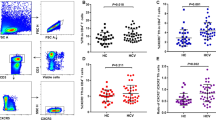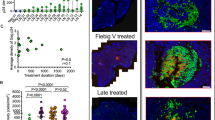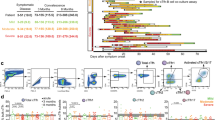Abstract
LARGE amounts of human immunodeficiency virus (HIV) localize on follicular dendritic cells (FDC) in the follicles of secondary lymphoid tissues following viral infection1,2. During clinical latency, active viral infection occurs primarily at these sites3,4. As HIV on FDC is in the form of immune complexes5, some of which may be formed with neutralizing antibody, we investigated whether HIV on FDC is infectious. We report here that HIV on FDC is highly infectious. Furthermore, FDC can convert neutralized HIV into an infectious form even in the presence of a vast excess of neutralizing antibody. Thus FDC may provide a mechanism whereby HIV infection can continue in the presence of neutralizing antibody.
This is a preview of subscription content, access via your institution
Access options
Subscribe to this journal
Receive 51 print issues and online access
$199.00 per year
only $3.90 per issue
Buy this article
- Purchase on Springer Link
- Instant access to full article PDF
Prices may be subject to local taxes which are calculated during checkout
Similar content being viewed by others
References
Racz, P., Tenner-Racz, K. & Schmidt, H. Acta path. microbiol. immun. Scand. (suppl.) 8, 16–23 (1989).
Biberfeld, P. et al. Cancer Detect. Prev. 12, 217–224 (1988).
Pantaleo, G. et al. Nature 362, 355–358 (1993).
Embretson, J. et al. Nature 362, 359–362 (1993).
Fox, C. H. & Cottler-Fox, M. Immun. Today 13, 353–356 (1992).
Tenner-Racz, K. et al. in Accessory Cells in HIV and Other Retroviral Infections (eds Racz, P., Dijkstra, C. D. & Gluckman, J. C.) Vol. 1. 83–97 (Karger, Basel, 1991).
Tew, J. G., Mandel, T. E. & Miller, G. A. Aust. J. exp. Biol. med. Sci. 57, 401–414 (1979).
Szakal, A. K., Holmes, K. L. & Tew, J. G. J. Immun. 131, 1714–1727 (1983).
Burton, G. F., Conrad, D. H., Szakal, A. K. & Tew, J. G. J. Immun. 150, 31–38 (1993).
Chesebro, B. & Wehrly, K. J. Virol. 62, 3779–3788 (1988).
Gray, D., Kosco, M. H. & Stockinger, B. Int. Immun. 3, 141–148 (1991).
Tew, J. G., Greene, E. J. & Makoski, M. H. Cell Immun. 26, 141–152 (1976).
Tew, J. G., Burton, G. F. & Szakal, A. K. in Handbook of Experimental Immunology: The Lymphoid System Antibody Responses and Affinity Maturation (ed. Nossal, G. J. V.) (Rockwell Scientific, Oxford, in the press).
Butch, A., Chung G., Hoffmann, J. & Nahm, M. J. Immun. 150, 39–47 (1993).
Butch, A. W., Hug, B. A. & Nahm, M. H. Cell Immun. 155, 27–41 (1994).
Camron, P. U. et al. Science 257, 383–387 (1992).
Ou, C. et al. Science 239, 295–297 (1988).
Bauer, H. M. et al. J. Am. med. Soc. 265, 472–477 (1991).
Clouse, K. A. et al. J. Immun. 142, 431–438 (1989).
Folks, T. M. et al. Proc. natn. Acad. Sci. U.S.A. 86, 2365–2368 (1989).
Mann, D. L. et al. AIDS Res. hum. Retrovir. 5, 253–255 (1989).
Popovic, M., Sarngadharan, M. G., Read, E. & Gallo, R. Science 224, 497–500 (1984).
Kosco, M. H., Pflugfelder, E. & Gray, D. J. Immun. 148, 2331–2339 (1992).
Mandel, T. E., Phipps, R. P., Abbot, A & Tew, J. G. Immun. Rev. 53, 29–59 (1980).
Pincus, S., Wehrly, K. & Chesebro, B. J. Immun. 142, 3070–3075 (1989).
Gelderblom, H. R., Hausmann, E. S. H., Ozel, M., Pauli, G. & Koch, M. A. Virology 156, 171–176 (1987).
Posner, M. R., Cavacini, L. A., Emes, C. L., Power, J. & Byrn, R. J. Acqu. Immun. Defic. Syndr. 6, 7–14 (1995).
Posner, M. R. et al. J. Immun. 146, 4325–4332 (1991).
Burton, D. R. et al. Science 266, 1024–1027 (1994).
Author information
Authors and Affiliations
Rights and permissions
About this article
Cite this article
Heath, S., Tew, J., Tew, J. et al. Follicular dendritic cells and human immunodeficiency virus infectivity. Nature 377, 740–744 (1995). https://doi.org/10.1038/377740a0
Received:
Accepted:
Issue Date:
DOI: https://doi.org/10.1038/377740a0
This article is cited by
-
Within-Host Viral Dynamics in a Multi-compartmental Environment
Bulletin of Mathematical Biology (2019)
-
The role of follicular helper CD4 T cells in the development of HIV-1 specific broadly neutralizing antibody responses
Retrovirology (2018)
-
Impaired B cells survival upon production of inflammatory cytokines by HIV-1 exposed follicular dendritic cells
Retrovirology (2016)
-
Are T cells the only HIV-1 reservoir?
Retrovirology (2016)
-
Stable multi-infection of splenocytes during SIV infection - the basis for continuous recombination
Retrovirology (2012)
Comments
By submitting a comment you agree to abide by our Terms and Community Guidelines. If you find something abusive or that does not comply with our terms or guidelines please flag it as inappropriate.



